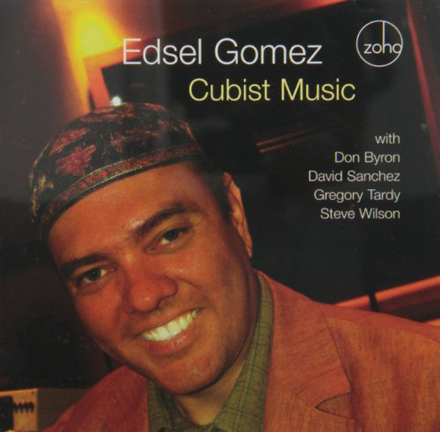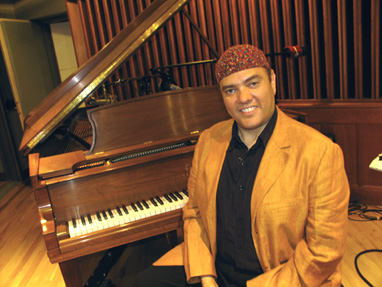|
Edsel Gomez
Cubist Music
2007 GRAMMY Nominee in Latin Jazz Category!
Release Date: January 12, 2006
Selection #: ZM200601
Songs:
1. Wolfville
2. To the Lord
3. The Minetta Triangle
4. Lady Bug
5. Juan Tizol
6. The 3 – 3 Clave
7. Empty House
8. Coqui Serenade
9. W 54th Street Theme
10. NYC Taxi Ride
11. The "Adoracion" Variations
12. Harmolodic Collage
13. Molly
|
Musicians:
Edsel Gomez - Piano, compositions and arrangements
Don Byron - Clarinet
David Sanchez - Tenor Sax
Miguel Zenon - Alto Sax
Steve Wilson - Alto sax & Flute
Greg Tardy - Tenor Sax, Bass Clarinet & Flute
Drew Gress - Acoustic Bass
Bruce Cox - Drums
Tom Lazarus - Recording Engineer
Recorded at Harmolodic Studios, Harlem, NYC
Mixed at Classic Sound by Don Byron, Tom Lazarus and Edsel Gomez
Produced by Don Byron
|
 |
|
DECEMBER 8, 2006 NEWS FLASH :
Edsel Gomez's ZOHO CD release CUBIST MUSIC was just nominated for a GRAMMY in the Latin Jazz category! Award ceremony is on Sunday, February 11, 2006 at the STAPLES CENTER in Los Angeles, CA - and will be broadcast live by CBS TV!
For his Stateside debut as a leader, Edsel Gomez could have introduced his wonderful keyboard facility, deft touch and advanced sense of harmony to American jazz fans in a more conventional piano trio setting. Instead, he aimed much higher. With Cubist Music, an auspicious debut that showcases his expansive musical vision, the native of Puerto Rico and resident of New York City puts theory into action with wholly satisfying results.
Accompanied by a world-class crew consisting of clarinetist Don Byron, tenor saxophonists David Sanchez and Greg Tardy, alto saxophonists Miguel Zenon and Steve Wilson, bassist Drew Gress and drummer Bruce Cox -- all bandleaders and composers in their own right as well as being among the most important players and improvisers of their generation -- Gomez fully explores his concept for which this album is named. “The basic principle of Cubist music is very simple and can change the way a musician improvises instantly,” he maintains.
In essence, Gomez’s idea of Cubist music is a translation of Cubist art from visual to aural perception. “In very much the same way a Cubist painting portrays an image by combining cubes or building blocks, this concept consists of a search for melodies or patterns that are perceived to have a beginning and an end,” he explains. “I call these melodic motifs or complete unit patterns we search for ‘unitifs.’ For this recording, musicians were requested to search for these unitifs within their improvised lines and build their solos by juxtaposing and contrasting different unitifs just like cubes in a Cubist painting.”
Edsel adds that his first Cubist music epiphany came to him sometime after moving to New York in 1997. “I would go out to different places and hear so many great players who have so much music to offer. Everywhere you go in New York, even on the subway, you find somebody playing great. So I would hear all of this stuff and remember what somebody would play -- maybe one phrase that caught my attention. And I would think, ‘If I could just play one idea and then construct another idea to this one where one is fueled by another; if I could take the ideas that I like and just make a music out of those little ideas, that would be something unique.’”
He began experimenting with the concept while playing a gig in Philadelphia with David Sanchez and noticed immediate results. “I started employing these ideas on the bandstand and I felt that the audience reacted differently to what I played. And not only that, the guys around me reacted differently too. So I knew then that I was onto something and that I would have to work to develop this concept.”
Edsel’s process of breaking a melody up into small unitifs or fragments and then organizing them into an organic whole ultimately led to this Cubist Music project. It’s a remarkably ambitious and musically rewarding debut by the gifted pianist-composer who has earned a sterling reputation on New York’s highly competitive jazz scene.
Born in 1962 in Bayamon, near San Juan, Gomez began studying piano at age five. After copying the montunos of salsa star Eddie Palmieri, he started his first band at age nine and joined an amateur orchestra the following year. Inspired by jazz as a teenager, he enrolled at the Berklee College of Music in Boston in 1980, graduating in 1985. It was in Boston that Edsel met and befriended clarinetist Don Byron, who would become a key collaborator. Gomez has since appeared on three Byron recordings -- 1991’s Tuskeegee Experiments, 1995’s Music for Six Musicians and 2001’s You Are #6. “I met Don at the New England Conservatory in a rehearsal for somebody and what he was playing immediately caught my attention. I asked him what was he doing. He was very patient and showed me, and we became friends right away. He’s got an amazing mind. And it was that experience of playing with Don that led me to discover many things in music.”
In 1987, Gomez moved to Sao Paulo, Brazil, where he lived for ten years and recorded three albums as a leader which were released in Brazil only. In 1997, he relocated to New York and began playing in a band led by David Sanchez, subsequently appearing on four Grammy-nominated recordings with the acclaimed tenor saxophonist -- 1998’s Obsession, 2000’s Melazza, 2001’s Travesia and 2004’s Coral. He has also appeared on recordings by guitarists Freddie Bryant and Sandro Albert, bassist Richard Bona, trombonist William Cepeda, trumpeter Tony Lujans and singers Janis Siegel and Eric Benet. He also plays on trombonist Conrad Herwig’s Grammy-nominated live at the Blue Note recording, Latin Side of Miles. All of these varied sideman experiences have enriched his own musical vocabulary and culminated in Edsel’s most fully realized project to date.
|
 Edsel Gomez, New York, June 2005. Photo : Sergio Royzen Edsel Gomez, New York, June 2005. Photo : Sergio Royzen
The collection opens with the turbulent “New York Taxi Ride,” a Cubist reading of ‘Caravan’ which is brimming with jagged bits of dissonance and propelled by surging, off-kilter rhythms. “To The Lord”is Edsel’s musical offering “in gratefulness to the Lord for granting us the Blessing of his Music and the opportunity to share it with such great artists in this recording.”
The serene piano trio number, “Wolfville,” is a Cubist reading of Heitor Villa-Lobos’s “Trenzinho do Caipira” that highlights the flexibility and sensitivity of his stellar rhythm section. On the explosive “Lady Bug,” Gomez incorporates some startling keyboard techniques that he picked up from the late Don Pullen. “I was going for some more avant-garde elements there and I used some things that Don actually laid on me and encouraged me to explore many years ago.” Steve Wilson, David Sanchez and Don Byron all turn in outstanding solos here.
“Juan Tizol” is Edsel’s homage to the Puerto Rican trombonist and longtime Duke Ellington sideman who composed “Perdido” and co-composed “Caravan.” “The Minetta Triangle” is a quirky blues showcasing some bravura soloing from Byron and Sanchez. “Coqui Serenade” is named for the tiny croaking frog that inhabits the island of Puerto Rico and makes a distinctive sound at night that every Puerto Rican native associates with home. Edsel’s lush arrangement on this nostalgic offering features dual flute work by Wilson and Tardy, interwoven with Byron’s clarinet and Tardy’s bass clarinet.
On the sorrowful “Empty House,” Gomez engages in an intimate dialogue with bassist and masterful improviser Drew Gress while on the probing solo piano piece, “The Adoracion Variations,” he offers a heartfelt extrapolation on a salsa classic by the great Eddie Palmieri. As he explains, “Eddie has been like a mentor to me and I feel a close connection to him. So in this piece I make variations out of the melody line of his classic ‘Adoracion,’ a tune that every musician studying Latin music would recognize.”
“Harmolodic Collage” is a collection of snippets from the session that was spliced together by Mark Stedman while “W 54th St. Theme” is a Cubist portrait of the late night atmosphere around the Bistro Latino, where Edsel played four nights a week soon after ariving in New York. As he recalls, “We would leave from the gig at 2 a.m., go outside and know everybody on the street -- the guy on the corner giving out fliers for strip joints, the taxi drivers, other musicians. There was one taxi driver who became my friend and would drive me home after the gig. So this is a nostalgic piece about that area.”
On “The 3-3 Clave” Edsel investigates the three side of the fundamental Afro-Cuban rhythm. “One of the eternal disagreements among musicians who work in Latin music is where to put the two and where to put the three in the clave,” he explains. “So I decided to make a piece that would have that feeling of the three side represented.” Byron, Wilson and Tardy add fire to this clave workout.
Cubist Music closes on a contemplative note with an intimate solo piano rendition of Don Byron’s “Molly.” Says Gomez, “That’s a tune that we used to play a lot in college together when he was in New England Conservatory and I was in Berklee. At the end of the session I just started playing this piece and Don was very surprised to hear it again after all these years. He had to clarify some chords for me, and I was pleased to include it on the album as a thank you note to Don for his inspiration and teachings for so many years.”
As a composer, arranger, player and conceptualist, Gomez is clearly a talent deserving of wider recognition. -- Bill Milkowski
Recorded at Harmolodic Studios, Harlem, NYC. Tom Lazarus - Recording Engineer. Mixed at Classic Sound by Don Byron, Tom Lazarus and Edsel Gomez, in June 2005. Produced by Don Byron. Photography Sergio Royzen. Package Design 3+Co. (www.threeandco.com) Executive producer: Willie and Julio Gomez Rentas, Joachim Becker.
|
|
|
|

